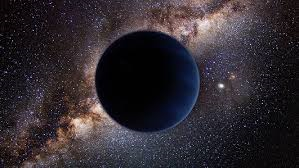A newly discovered asteroid’s unusual orbit supports the idea that a massive planet lurks in the far reaches of the solar system
An enormous planet containing 10 times the mass of the Earth could explain the unusual orbit of a newly discovered asteroid. If found, the giant world would represent the first discovery of a planet in our solar system since Pluto in 1930, and before that Neptune in 1846. (Pluto was subsequently downgraded from planet to “dwarf planet” in 2006.)
The asteroid in question is called 2015 BP519. It was discovered three years ago at fifty-five times the Earth’s distance to the sun. Since that time, a group of astronomers led by Juliette Becker of the University of Michigan have been tracking it.
They now conclude the space rock is following a highly unusual orbit that is most easily explained if the gravity of a large – as yet unseen – planet has pulled it into place.
2015 BP519’s orbit takes it from 35 to 863 times the radius of Earth’s orbit, but the weird part is that it is inclined to the orbits of Earth, the other planets and most of the asteroids by 54 degrees. If we presume BP519 formed in the same plane as the other members of the solar system, its tilt requires a large gravitational pull to have hoisted it into position.
Becker and colleagues ran computer simulations. As soon as they put a distant planet in their models, its gravity made the orbit of 2015 BP519 understandable, the researcher told Quanta magazine.
The idea of an undiscovered planet beyond Neptune has been gaining popularity in astronomical circles since 2014. This was when astronomers Chadwick A Trujillo and Scott S Sheppard noticed that a couple of objects in the outer solar system appeared to have been shepherded into place by some large object’s gravity. They suggested a world between two and 15 times the mass of the Earth could be doing this.
In 2016, astronomers Konstantin Batygin and Michael E Brown looked at other distant objects and came to similar conclusions. They suggested a planet of around 10 Earth masses and computed a possible orbit. It is this hypothetical planet – known as Planet Nine – that Becker used in her analysis.
Although the evidence cannot yet be seen as definitive, the ease with which the newly discovered asteroid fits into the Planet Nine scenario is certainly persuasive.
But even if it is out there, finding the new world will be extremely difficult. It could be hundreds of times further from the sun than the Earth, and that would make it incredibly faint because it would emit no light of its own.
If it is there, it would be a spectacular find. It could represent a class of planet that astronomers have never seen close-up before: a super-Earth.
Super-Earths contain up to 10 times the mass of the Earth and have been found in relative abundance around other stars but not in our own solar system, where Earth is the largest rocky planet. Uranus, a gas giant planet, is the next largest planet, at 14.5 times Earth’s mass.
If Planet Nine is indeed a super-Earth, astronomers will be keen to measure its mass and diameter in order to calculate its density and therefore deduce its composition. A gaseous planet will be less dense and therefore larger than a rocky or predominantly metallic world.
But first they have to find if Planet Nine is really out there. To do that, more objects like 2015 BP519 are needed. As these distant asteroids are detected and tracked, they will help triangulate where the planet is likely to be. Telescopes can then begin the search.
If more objects are found and do not corroborate the idea, then astronomers will eventually turn away from the Planet Nine hypothesis and search for other ways of explaining this strangely inclined population of distant asteroids.
The Guardian
 Lebanese Ministry of Information
Lebanese Ministry of Information



